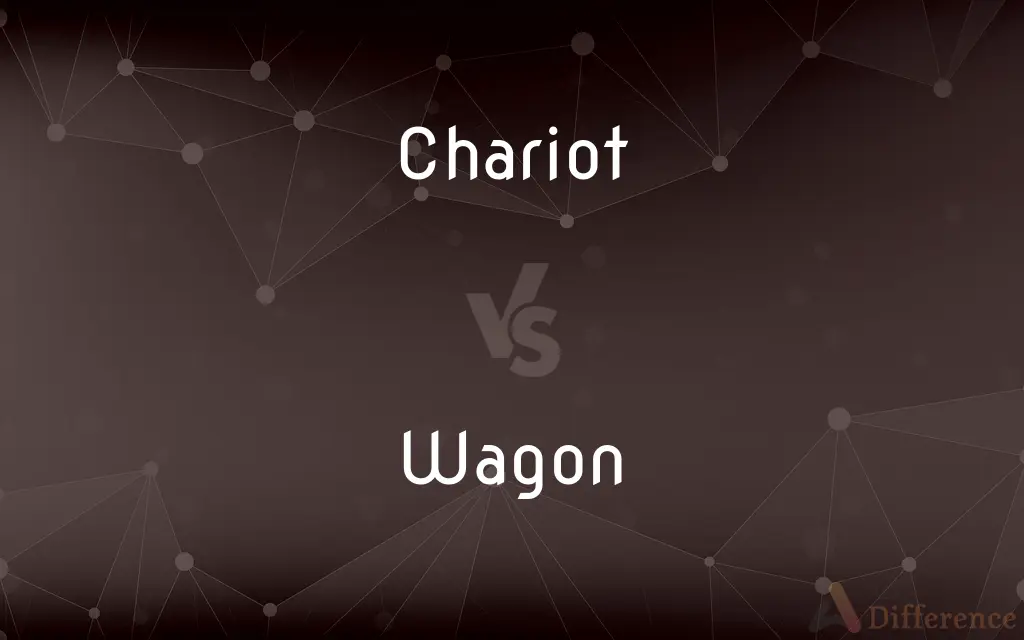Chariot vs. Wagon — What's the Difference?
By Tayyaba Rehman & Urooj Arif — Updated on April 1, 2024
A chariot is a two-wheeled vehicle driven by horses, used historically in battles and races, while a wagon is a four-wheeled vehicle for transporting goods or people, often pulled by animals.

Difference Between Chariot and Wagon
Table of Contents
ADVERTISEMENT
Key Differences
Chariots were primarily used in ancient warfare and for racing, designed for speed, maneuverability, and as platforms for archers or spear-throwers. Wagons, however, serve a utilitarian purpose, transporting goods, agricultural products, or people over longer distances, prioritizing capacity and stability over speed.
While chariots are characterized by their lightweight construction and open design, allowing for quick movements and efficient use in combat or competition, wagons are built more sturdily, often enclosed or partially covered, to protect the cargo or passengers.
The historical significance of chariots is profound, symbolizing status, military prowess, and technological advancement in ancient civilizations, including the Egyptians, Romans, and Chinese. Wagons, on the other hand, played a crucial role in the development of agriculture, trade, and the expansion of territories, especially in the American West.
Chariots were typically pulled by two or four horses, arranged side by side, enhancing their speed and agility. Wagons, with their heavier load, were often drawn by multiple animals, including horses, oxen, or mules, arranged in pairs to distribute the weight evenly.
Comparison Chart
Wheels
Two-wheeled
Four-wheeled
ADVERTISEMENT
Purpose
Warfare, racing
Transporting goods, people
Design
Lightweight, open
Sturdy, often enclosed
Historical Use
Symbol of status and military might
Key in agriculture, trade, expansion
Animal Power
Pulled by two to four horses
Pulled by horses, oxen, or mules
Compare with Definitions
Chariot
Symbolic in many ancient cultures.
Chariots are depicted in numerous historical artifacts, indicating their importance.
Wagon
Enclosed or partially covered to protect contents.
The covered wagon protected the family from the elements during their journey.
Chariot
A two-wheeled vehicle used in ancient warfare and races.
The chariot raced across the plains, driven by expert hands.
Wagon
A four-wheeled vehicle for transporting goods or people.
The farmer loaded his produce onto the wagon for market day.
Chariot
Designed for speed and maneuverability.
Chariots were essential for quick movements on the battlefield.
Wagon
Often pulled by multiple animals for power.
The heavy wagon was drawn by a team of oxen, steady and strong.
Chariot
Often used by high-status individuals.
Kings and generals would ride chariots to showcase their power.
Wagon
Designed for capacity and stability.
Wagons were built to carry heavy loads over rough terrains.
Chariot
Pulled by horses, typically two or four.
The chariot, pulled by four horses, was a sight to behold.
Wagon
Used widely in agriculture and settlement expansion.
Settlers used wagons to carry their belongings as they moved west.
Chariot
A chariot is a type of carriage driven by a charioteer, usually using horses to provide rapid motive power. The oldest known chariots have been found in burials of the Sintashta culture in modern-day Russia, dated to c.
Wagon
A wagon or waggon is a heavy four-wheeled vehicle pulled by draught animals or on occasion by humans, used for transporting goods, commodities, agricultural materials, supplies and sometimes people. Wagons are immediately distinguished from carts (which have two wheels) and from lighter four-wheeled vehicles primarily for carrying people, such as carriages.
Chariot
An ancient horse-drawn two-wheeled vehicle used in war, races, and processions.
Wagon
A vehicle used for transporting goods or another specified purpose
A breakdown wagon
A timber wagon
Chariot
A light four-wheeled carriage used for occasions of ceremony or for pleasure.
Wagon
An unpleasant or disliked woman.
Chariot
To convey or ride in a chariot.
Wagon
A four-wheeled, usually horse-drawn vehicle with a large rectangular body, used for transporting loads.
Chariot
A (two-wheeled) horse-drawn cart, used in Bronze Age and Early Iron Age warfare.
Wagon
A light automotive transport or delivery vehicle.
Chariot
A light (four-wheeled) carriage used for ceremonial or pleasure purposes.
Wagon
A station wagon.
Chariot
(xiangqi) rook
Wagon
A police patrol wagon.
Chariot
To convey by, or as if by, chariot.
Wagon
A child's low, four-wheeled cart hauled by a long handle that governs the direction of the front wheels.
Chariot
(intransitive) To ride in a chariot.
Wagon
A small table or tray on wheels used for serving drinks or food
A dessert wagon.
Chariot
A two-wheeled car or vehicle for war, racing, state processions, etc.
First moved the chariots, after whom the foot.
Wagon
Wagon The Big Dipper
Chariot
A four-wheeled pleasure or state carriage, having one seat.
Wagon
Chiefly British An open railway freight car.
Chariot
To convey in a chariot.
Wagon
To transport or undergo transportation by wagon.
Chariot
A light four-wheel horse-drawn ceremonial carriage
Wagon
A heavier four-wheeled (normally horse-drawn) vehicle designed to carry goods (or sometimes people).
Chariot
A two-wheeled horse-drawn battle vehicle; used in war and races in ancient Egypt and Greece and Rome
Wagon
Abbreviation of toy wagon; A child's riding toy, with the same structure as a wagon (sense 1), pulled or steered by a long handle attached to the front.
Chariot
Transport in a chariot
Wagon
(rail) A vehicle (wagon) designed to transport goods or people on railway.
Chariot
Ride in a chariot
Wagon
(slang) transporting]] prisoners
Wagon
; (by extension) a sport utility vehicle (SUV); any car.
Wagon
A woman of loose morals, a promiscuous woman, a slapper; (by extension) a woman regarded as obnoxious; a bitch, a cow.
Thesaurus:promiscuous woman
Wagon
(math) A kind of prefix used in de Bruijn notation.
Wagon
(slang) Buttocks.
Wagon
To load into a wagon in preparation for transportation; to transport by means of a wagon.
Wagon
To travel in a wagon.
Wagon
A wheeled carriage; a vehicle on four wheels, and usually drawn by horses; especially, one used for carrying freight or merchandise.
Wagon
A freight car on a railway.
Wagon
A chariot
Wagon
The Dipper, or Charles's Wain.
Wagon
To transport in a wagon or wagons; as, goods are wagoned from city to city.
Wagon
To wagon goods as a business; as, the man wagons between Philadelphia and its suburbs.
Wagon
Any of various kinds of wheeled vehicles drawn by a horse or tractor
Wagon
Van used by police to transport prisoners
Wagon
A group of seven bright stars in the constellation Ursa Major
Wagon
A child's four-wheeled toy cart sometimes used for coasting
Wagon
A car that has a long body and rear door with space behind rear seat
Common Curiosities
Can wagons be used for purposes other than transportation?
Primarily, wagons are for transportation, but they've also been used as mobile homes or shelters, especially during the expansion of the American West.
Were chariots used in battle in all ancient cultures?
Chariots were used in many, but not all, ancient cultures, especially by the Egyptians, Romans, and Chinese for military purposes and status symbols.
How were wagons adapted for different terrains or uses?
Wagons were modified with different wheel sizes, coverings, and structures to suit various terrains, loads, and weather conditions.
What role did wagons play in the development of societies?
Wagons facilitated agricultural development, trade, and territorial expansion by enabling the transportation of goods and people over long distances.
Are chariots still used today?
Chariots are primarily seen in historical reenactments, parades, or cultural celebrations, not as a mode of transportation or warfare.
How did chariots impact ancient warfare?
Chariots allowed for rapid, mobile attacks and were status symbols in ancient armies, significantly impacting military tactics and outcomes.
Why did chariots fall out of use in warfare?
Chariots became obsolete with the advent of cavalry forces, which were more versatile and effective in varied terrains.
What advancements replaced wagons for transportation?
The development of railroads and motor vehicles eventually supplanted wagons for most long-distance and commercial transportation needs.
What distinguishes a chariot from a wagon?
Chariots are two-wheeled, designed for speed and combat, while wagons are four-wheeled, built for transporting goods or people.
How did the use of wagons influence economic development?
Wagons significantly impacted economic development by improving the efficiency of goods transportation, thus expanding markets and trade.
Did the design of chariots vary between cultures?
Yes, chariot designs varied significantly across cultures, reflecting differences in technology, terrain, and military tactics.
Were chariots used in any ancient sports or games?
Yes, chariot racing was a popular sport in ancient Rome and Greece, attracting large audiences to arenas like the Circus Maximus.
How did the construction of wagons evolve over time?
Wagon construction evolved to include more durable materials, better suspension systems, and designs tailored to specific transportation needs.
What factors influenced the design and use of chariots in ancient times?
Factors included the level of technological advancement, terrain, military tactics, and the symbolic status associated with chariot use.
What materials were used to build ancient chariots and wagons?
Both chariots and wagons were primarily constructed from wood, with metal fittings for reinforcement and decoration; chariots, however, were designed to be lighter.
Share Your Discovery

Previous Comparison
Decline vs. Incline
Next Comparison
Basic vs. EssentialAuthor Spotlight
Written by
Tayyaba RehmanTayyaba Rehman is a distinguished writer, currently serving as a primary contributor to askdifference.com. As a researcher in semantics and etymology, Tayyaba's passion for the complexity of languages and their distinctions has found a perfect home on the platform. Tayyaba delves into the intricacies of language, distinguishing between commonly confused words and phrases, thereby providing clarity for readers worldwide.
Co-written by
Urooj ArifUrooj is a skilled content writer at Ask Difference, known for her exceptional ability to simplify complex topics into engaging and informative content. With a passion for research and a flair for clear, concise writing, she consistently delivers articles that resonate with our diverse audience.














































